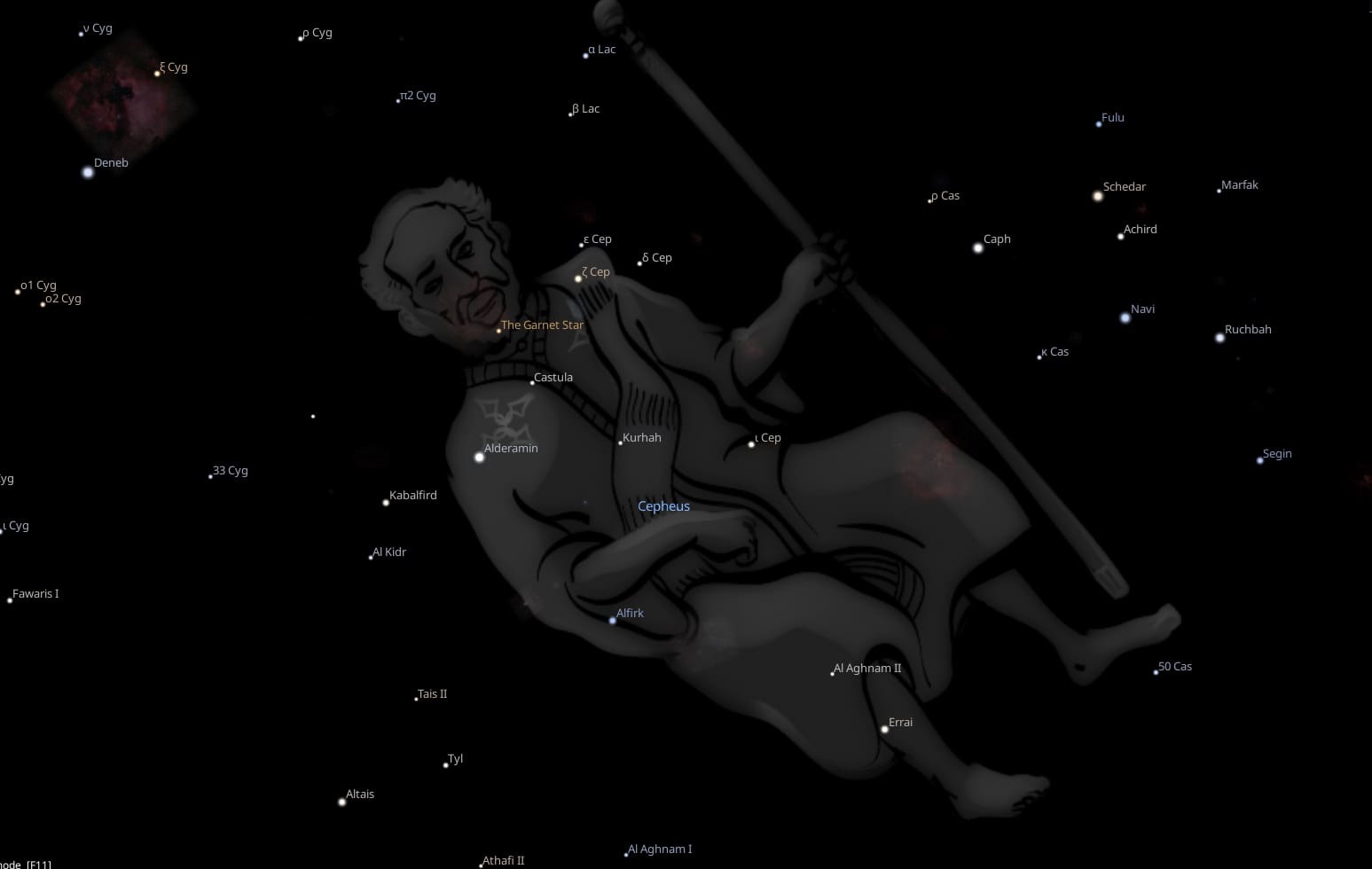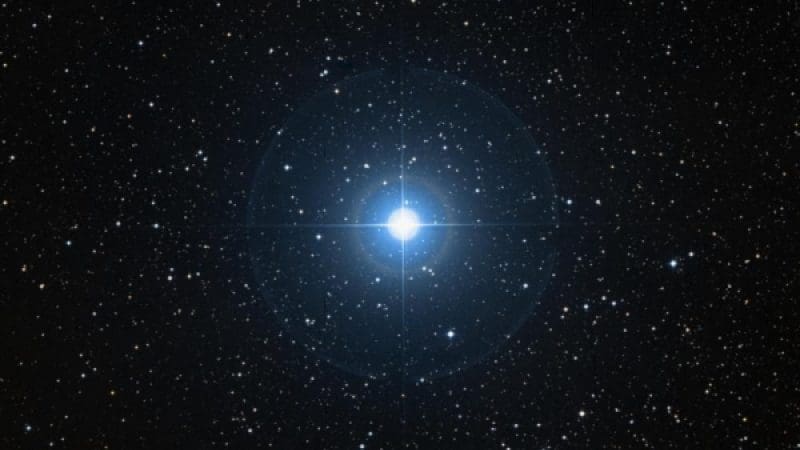FIXED STARS: Major Stars | 1000+ Stars | Constellations | About
Kurhah at 24°13′ Aries has an orb of 1°20′
The Sun joins Kurhah on April 14
Fixed star Kurhah, Xi Cephei, is a 4th magnitude multiple star system in the chest of the King, Constellation Cepheus. Combined magnitude 4.29, Spectral class A3, color blue-white.
- ξ Cephei A, spectroscopic binary, magnitude 4.45, spectral type A3.
- ξ Cephei B, spectroscopic binary, magnitude 4.60, spectral type F8.
- ξ Cephei C, magnitude 13. [1]
Xi Cephei is officially named Kurhah.
ξ Kurhah: Applied in recent times from one vocalization of its Indigenous Arabic name: al-qurha, ‘the White Spot on the Forehead of a Horse.” However, the original Arabic script for the name can be read and vocalized in other ways with various meanings. [2]
ξ, Binary, 4.5 and 7, blue: Kazwini called this Al Ḳurḥaḥ (القرحة al-qurhah), an Arabic word that Ideler translated as a white spot, or blaze, in the face of a horse, but thinking this not a proper stellar name, suggested Al Ḳirdah (ألقردة al qírada), the Ape. Hewitt claims that to the prehistoric ancestors of the Hindus, Cepheus represented Kapi, the Ape-God. [3]
| 2000* | 2050 | Name | Orb |
| 21♈57 | 22♈39 | Baten Kaitos | 2°10′ |
| 23♈16 | 23♈59 | Acamar | 2°00′ |
| 24♈13 | 24♈55 | Kurhah | 1°20′ |
| 26♈49 | 27♈31 | Al Pherg | 2°10′ |
| 27♈51 | 28♈33 | Vertex | 1°30′ |
Kurhah Astrology
Fixed star Kurhah has the spectral class A3 + F8, indicating a Venus/Mercury planetary nature. It gives a neat, pleasant appearance and a thoughtful, polite, intellectual, sociable and serious nature: determination, sincerity, endurance, a good memory, psychic ability, idealism, good judgment, authority, prominence, eminence, and help from friends and wealthy patrons.
Kurhah also gives interest or talent in literature, history, philosophy, music, poetry, art, science, medicine, politics, astrology, education, journalism, justice, and philanthropy. The ability to cooperate and compromise gives diplomatic skills.
Positive aspects bring good fortune, success, honor, wealth, unexpected gains and fame. Harsh aspects can cause a selfish, demanding, and foolish nature, rise followed by fall, anxiety, melancholy, impulsiveness, indiscretion, scandal and self-destruction.
The Druid Star
Kurhah is the Druid Star. It holds ancient knowledge learned and accumulated over millennia. This vast store of scientific, astronomical, medical, cultural and occult knowledge was only shared orally and was lost to humanity in the Menai Massacre of 60 AD.
Kurhah is directly opposite the fixed star Arcturus in the zodiac:
- 24°13′23″ Aries – ξ Cephei, Kurhah
- 24°13′58″ Libra – α Boötis, Arcturus
Compared to the military theme of the Aldebaran/Antares axis, the opposition between Kurhah and Arcturus creates a spiritual axis that acts like a wormhole for soul memory and a portal for the soul.
Both stars give psychic and occult powers that allow access to other realms of consciousness. Kurhah offers insights about the past, while Arcturus is more associated with future insights.
Kurhah gives a strong sense of duty or purposefulness to use the acquired knowledge for a definite mission. There is also a heavy sense of personal responsibility to complete something significant that may have been worked on for many incarnations.
In medical astrology, Kurhah rules the pituitary gland, the master gland of the body. Ginkgo biloba enhances it, opium moderates it, and Cannabis restricts it.
Constellation Cepheus
According to Ptolemy, Cepheus is like Saturn and Jupiter. It gives authority and a sober mind, sometimes making its natives judges or arbitrators, but exposes to cruel and severe trials. If Mars afflicts the luminaries from Cepheus, especially if in an angle, it causes death by hanging, decapitation, crucifixion or impalement. By the Kabalists, this constellation is associated with the Hebrew letter Shin and the 22nd Tarot Trump, “The Fool.” [4]
In classical times, Cepheus was said to have presaged earthquakes and other events that affected large portions of mankind. [5]
Cepheus was the inventor of astronomical science. [6]
The ancient astronomers were Cepheans, who made Cepheus the father of their royal family of stars. [7]
Kurhah Star Conjunctions
Ascendant conjunct Kurdah: Janio Quadros 0°00′, Stéphane Mallarmé 0°00′, Robert Lacey 0°02′, William Henry Drummond 0°16′ (and Sun), Howard Baker 0°17′, Octave Mirbeau 0°24′, Liz Renay 0°31′ (and Sun), Ken Myer 0°32′, Yvonne Kenny 0°34′, Marcel Proust 0°37′, Michel Eugène Chevreul 0°44′, Errol Flynn 0°54′, Harry Nilsson 1°19′, Trish McKelvey 1°19′.
Midheaven conjunct Kurdah: Pierre Molinier 0°05′, Gregor Strasser 0°07′, Robert O. Anderson 0°08′, Dean Beard 0°12′, Paul Rosbaud 0°13′, Joan Miró 0°15′, Tama Janowitz 0°18′, Alanis Morissette 0°24′, Neville Heath 0°25′, Maurice Chevalier 0°32′, Lord Acton 0°34′, John Hurt 0°35′ (and S. Node), Agnetha Fältskog 0°40′ (and Mercury), George W. Bush 0°43′, Marjoe Gortner 0°49′, Yul Brynner 0°53′, Dorothy Dandridge 0°55′, Lisa Andersen 0°56′ (and Venus, Saturn), Prince Andrew, Duke of York 1°00′.
Descendant conjunct Kurdah: Henry IV of France 0°10′, José Carreras 0°28′ (and Moon), Charles E. Burchfield 1°05′, Magda Szubanski 1°11′ (and Sun).
Imun Coeli conjunct Kurdah: James Van Praagh 0°21′ (and S. Node), Diana, Princess of Wales 0°37′, Samuel Hahnemann 0°43′ (and Sun), Richard Walther Dare 0°53′, Benjamin Creme 1°08′.
Sun conjunct Kurdah: Samuel Hahnemann 0°08′ (and IC), Lita 0°09′, David Letterman 0°13′, Charles Evans Hughes 0°23′, Garry Kasparov 0°32′, Madalyn Murray O’Hair 0°33′, Jett Travolta 0°35′, Liz Renay 0°38′ (and AC), William Henry Drummond 0°45′ (and AC), Ed O’Neill 0°54′, Adrien Brody 0°54′, Robert Watson-Watt 1°00′, Magda Szubanski 1°02′ (and DC), John Molony 1°02′, Samantha Fox 1°02′, Herbie Hancock 1°03′, Howard Sasportas 1°13′, Fisher Ames 1°14′, H. R. Giger 1°17′ (and Mars, S. Node) .
Moon conjunct Kurdah: Richard Tarnas 0°16′, Raymond Berry 0°16′, Patricia Neal 0°18′, Anderson Cooper 0°19′, Mark Rutte 0°21′, Carl XVI Gustaf 0°21′, Boxcar Willie 0°23′, Buddy Rose 0°23′, Agnetha Fältskog 0°29′ (and MC), Priscilla Chan 0°30′, Hugo Fischer 0°40′, Nin Hartley 0°44′, Steve Fossett 0°46′, Helene Cixous 0°47′, Heather Locklear 0°52′, Pierre-Auguste Renoir 0°53′ (and Venus), Arthur Shawcross 0°53′, Rob Schneider 0°59′, Francis Bean Cobain 1°01′, José Carreras 1°07′ (and DC), Bern Porter 1°08′, Gabriel Garcis Marquez 1°09′, Paul Tillich 1°09′, Bob Fosse 1°10′, Ben Barnes 1°12′.
Mercury conjunct Kurdah: Johannes Brahms 0°00′, Emile Zola 0°31′ (and Mars), Pierre Teilhard De Chardin 0°54′.
Venus conjunct Kurdah: Lady Gaga 0°08′, William Wordsworth 0°09′, Pierre-Auguste Renoir 0°38′ (and Moon), Lisa Andersen 1°16′ (and Saturn, MC).
Mars conjunct Kurdah: H. R. Giger 1°09′ (and MC, S. Node) Emile Zola 1°21′ (and Mercury).
Saturn conjunct Kurdah: Lisa Andersen 0°12′ (and Venus, MC).
South Node conjunct Kurdah: James Van Praagh 0°11′ (and IC), John Hurt 0°39′ (and MC), H. R. Giger 0°45′ (and Mars, MC).
References
- Xi Cephei, Wikipedia.
- A Dictionary of Modern Star Names, Kunitzch, Smart, 2006, p.29.
- Star Names: Their Lore and Meaning, Richard H. Allen, 1889, p.154-157.
- Fixed Stars and Constellations in Astrology, Vivian E. Robson, 1923, p.37.
- Fixed Stars and Judicial Astrology, George Noonan, 1990, p.12.
- Natural History, Pliny the Elder, AD 77, [VI.121]
- Stars, Stones and Scholars, Andis Kaulins, 2003, p.19-20, p.57-58.

